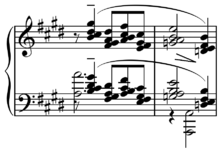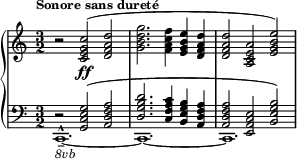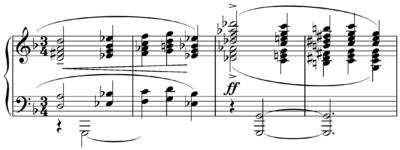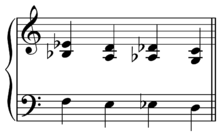In music, parallel harmony, also known as harmonic parallelism, harmonic planing or parallel voice leading, is the parallel movement of two or more lines (see voice leading). Examples may be found in Claude Debussy's Prélude à l'après-midi d'un faune (1894), Maurice Ravel's Daphnis and Chloë Suite No. 2 (1913), Richard Strauss's Elektra (1909), Arnold Schoenberg's Pierrot Lunaire, "Columbine" (1914), and William Schuman's Three Score Set for Piano (1944). In the last example, the inversions of the chords suggest a bichordal effect.[1]
 Diatonic planing from Feuilles mortes ("Dead Leaves") by Claude Debussy.[2] |  The "organ chords" in Debussy's tenth prélude, La cathédrale engloutie |
Lines with parallel harmony can be viewed as a series of chords with the same intervallic structure. Parallel means that each note within the chord rises or falls by the same interval.
In the example to the right, we see a series of quartal chords in parallel motion, in which the intervallic relationship between each consecutive chord member, in this case a minor second, is consistent. Each note in the chord falls by one semitone in each step, from F, B♭, and E♭ in the first chord to D, G, and C in the last.
See also
- Traditional sub-Saharan African harmony
- Consecutive fifths
- Constant structure
- Parallel key
- Parallel chord
- Side-slipping
- Doubling (music)
- Block chord
References
Notes
- ^ Kliewer, Vernon (1975). "Melody: Linear Aspects of Twentieth-Century Music", Aspects of Twentieth-Century Music, p.332 to 333. Wittlich, Gary (ed.). Englewood Cliffs, New Jersey: Prentice-Hall. ISBN 0-13-049346-5.
- ^ a b Cope, David (2000). New Directions in Music, p.6. ISBN 1-57766-108-7.

